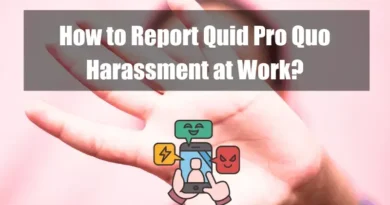Quid Pro Quo and Hostile Work Environment
Quid Pro Quo harassment involves a person in authority demanding sexual favors in exchange for job benefits or to avoid negative consequences, while a Hostile Work Environment arises from unwelcome conduct that is severe or pervasive enough to create an intimidating or offensive workplace atmosphere.
Takeaways
| Key Points |
|---|
| Definitions: – Quid Pro Quo: Employment benefits or opportunities are conditioned on submission to unwelcome sexual advances or conduct. – Hostile Work Environment: Unwelcome conduct based on protected characteristics, creating an intimidating or offensive work environment. – Empowering individuals and organizations to report and prevent harassment fosters a fair workplace. |
| Quid Pro Quo – Quid Pro Quo: Involves unwelcome conduct tied to tangible employment benefits, often with a power imbalance. – Explicit vs. Implicit Demands: Quid pro quo can be direct or indirect, making it harder to identify and prove. – Examples: Sexual quid pro quo (e.g., promotions for sexual favors) and non-sexual quid pro quo (e.g., religious conversion for better work schedules). – Legal Ramifications: Title VII of the Civil Rights Act of 1964 prohibits quid pro quo harassment, with potential consequences for employers and harassers. – Prevention and Reporting: Employers are legally obligated to prevent quid pro quo harassment through policies, training, and accessible reporting mechanisms. |
| Hostile Work Environment: – Unwelcome Conduct: Must be unwelcome, with severity and pervasiveness being key factors. – Examples: Verbal (offensive jokes, threats), nonverbal (offensive pictures, unwanted physical contact), and physical (assault, blocking movement) harassment. – Legal Ramifications: Prohibited under Title VII and various state/local laws. Employers are responsible for preventing and addressing hostile work environment harassment. – Prevention and Response: Creating a positive workplace culture, anti-harassment training, accessible complaint procedures, and employee support are essential. |
Introduction
Quid pro quo involves a specific exchange of unwelcome conduct for a job benefit or detriment, often explicit and involving a power imbalance. In contrast, a hostile work environment focuses on the pervasiveness and severity of unwelcome conduct, encompassing a broader range of behaviors and not necessarily individual-specific. Both are illegal forms of workplace harassment with distinct but overlapping characteristics.
Definition of Quid Pro Quo and Hostile Work Environment
Quid pro quo harassment, translating to “something for something,” occurs when employment benefits or opportunities are conditioned upon the employee’s submission to unwelcome sexual advances or other forms of conduct. This creates a power imbalance and can be explicit or implicit.
On the other hand, a hostile work environment refers to unwelcome conduct based on protected characteristics that are pervasive and severe enough to create an intimidating, hostile, or offensive work environment for a reasonable person. This conduct can be verbal, nonverbal, or physical and includes offensive jokes, slurs, threats, and physical assault.
Understanding quid pro quo and hostile work environments empowers individuals to report harassment, organizations to take preventative measures, and ultimately fosters a fair and productive workplace for everyone.
Differentiating Quid Pro Quo and Hostile Work Environment
A. Quid Pro Quo
1. Core Elements:
To prove quid pro quo harassment, the following elements must be established:
- Unwelcome Conduct: The employee must find the behavior offensive and unwelcome.
- Conditional Benefits: The conduct must be tied to tangible employment benefits like promotions or avoiding harm.
- Submission: The employee must either submit to the conduct or face negative consequences.
- Power Imbalance: The harasser must hold a position of authority over the employee.
2. Explicit vs. Implicit Demands:
Quid pro quo can be explicit, where demands are direct and unambiguous, like a supervisor offering a promotion in exchange for sex. However, it can also be implicit, conveyed through suggestive behavior, hints, or pressure, making it harder to identify and prove.
3. Power Dynamics at Play:
Quid pro quo thrives on power imbalances. The harasser leverages their authority to coerce or intimidate the employee into complying, creating an environment where resistance feels impossible due to potential career repercussions.
4. Examples of Quid Pro Quo Harassment
a. Sexual Quid Pro Quo
- Promotions and Favorable Treatment: A supervisor offers an employee a promotion or favorable treatment in exchange for sexual favors. This could include promises of a raise, better assignments, or positive performance reviews.
- Threats and Retaliation: A manager threatens to demote, transfer, fire, or otherwise negatively impact an employee’s career if they do not submit to sexual advances. This creates a situation where employees feel they have no choice but to comply.
- Implicit Demands: A coworker repeatedly makes suggestive comments or unwanted physical contact, leading the employee to believe that their continued employment is contingent on their submission.
b. Non-Sexual Quid Pro Quo
- Religious Conversion: A supervisor offers a better work schedule or favorable benefits in exchange for the employee’s conversion to their religion. This can create a coercive environment where employees feel pressured to comply with religious demands to maintain their jobs.
- Political Contributions: A manager promises a positive performance review or bonus in exchange for the employee’s political contributions to their favored candidate. This quid pro quo can violate the employee’s right to political freedom.
- Favors Outside of Work: A coworker offers to assist with personal errands or tasks in exchange for the employee overlooking a mistake they made at work. This blurs boundaries and can be considered an implicit quid pro quo.
5. Legal Ramifications of Quid Pro Quo
a. Title VII of the Civil Rights Act of 1964
Title VII prohibits discrimination based on sex, including quid pro quo harassment. This means that employers cannot condition employment benefits or opportunities on an employee’s submission to unwelcome sexual advances or other unwelcome conduct of a sexual nature. Employees experiencing quid pro quo harassment can file a charge with the Equal Employment Opportunity Commission (EEOC) or file a lawsuit in court.
b. State and Local Laws
Many states and localities have anti-discrimination laws beyond Title VII and may provide additional protections for employees experiencing quid pro quo harassment. These laws may cover additional types of harassment, such as harassment based on race, religion, disability, or sexual orientation.
c. Potential Consequences for Employers and Harassers
Employers found to be liable for quid pro quo harassment can face significant consequences, including:
- Monetary damages: Employees may be awarded back pay, lost wages, emotional distress, and punitive damages.
- Injunctive relief: Courts may order employers to cease engaging in discriminatory practices and implement corrective measures, such as anti-harassment training or changes to policies and procedures.
- Reputational damage: Public disclosure of quid pro quo harassment can damage an employer’s reputation and make it difficult to attract and retain qualified employees.
Individual harassers may also face disciplinary action, including termination of employment and personal liability for damages.
6. Prevention and Reporting of Quid Pro Quo
a. Employer Responsibilities
Employers have a legal obligation to prevent and address quid pro quo harassment. This includes:
- Developing and implementing clear and comprehensive anti-harassment policies. These policies should clearly define quid pro quo harassment, provide examples, and outline the reporting procedures.
- Providing regular anti-harassment training to all employees. This training should cover the legal definition of quid pro quo harassment, the employer’s anti-harassment policy, and how to report incidents.
- Creating a confidential and accessible reporting process. This includes establishing multiple reporting channels, such as a hotline, email address, or online form.
- Promptly and thoroughly investigating all reports of quid pro quo harassment. This includes interviewing the complainant and the alleged harasser, gathering evidence, and taking appropriate disciplinary action.
- Providing support and assistance to employees who experience quid pro quo harassment. This may include counseling, legal assistance, or job accommodations.
b. Employee Rights and Resources
Employees have the right to be free from quid pro quo harassment. This includes:
- The right to refuse unwanted sexual advances or requests for sexual favors.
- The right to report incidents of quid pro quo harassment without fear of retaliation.
- The right to be treated fairly and equally in the workplace.
Employees also have access to a variety of resources to help them deal with quid pro quo harassment, including:
- The Equal Employment Opportunity Commission (EEOC): The EEOC enforces federal laws prohibiting workplace discrimination, including harassment. Employees can file a charge with the EEOC if they are harassed.
- State and local agencies: Many states and localities have their laws and agencies that address workplace harassment.
- Employee assistance programs (EAPs): EAPs can provide confidential counseling and support to employees who have experienced harassment.
- Legal assistance: Employees may also want to consult an attorney to discuss their legal options.
c. Reporting Mechanisms and Investigations
Employers should provide multiple reporting mechanisms for employees to report incidents of quid pro quo harassment. These mechanisms should be confidential and accessible to all employees.
- Reporting Hotlines: Establish a dedicated hotline number that employees can call to report incidents of harassment. Ensure the hotline is accessible 24/7 and staffed by trained professionals.
- Email Reporting: Create a dedicated email address for employees to report harassment. This allows for asynchronous reporting and eliminates the need for face-to-face interaction.
- Online Reporting Forms: Develop online forms that employees can use to submit reports of harassment. This option can be convenient for employees who prefer to refrain from speaking about the incident directly.
- In-person Reporting: Ensure employees can report harassment directly to supervisors, HR representatives, or other designated individuals.
Following a report of quid pro quo harassment, employers should conduct a prompt and thorough investigation. This investigation should:
- Be conducted by a trained and impartial investigator.
- Include interviews with the complainant, the alleged harasser, and any witnesses.
- Gather all relevant evidence, including written documentation, emails, or text messages.
- Be completed promptly.
The employer should take appropriate disciplinary action once the investigation is complete. This may include:
- Issuing a warning or reprimand.
- Demoting or suspending the employee.
- Terminating the employee’s employment.
B. Hostile Work Environment
1. Unwelcome Conduct
The conduct must be unwelcome to the employee. The employee must not have invited or consented to the conduct. The employee’s subjective perception of the conduct as unwelcome is the key factor, not the harasser’s intent.
a. Severity and Pervasiveness of Conduct
For conduct to rise to the level of a hostile work environment, it must be severe or pervasive. Severe conduct is physically threatening, humiliating, or a significant detriment to the employee’s employment. Pervasive conduct is conduct that occurs frequently and over a prolonged period of time.
b. Objective and Subjective Standards
Courts use objective and subjective standards to determine whether a hostile work environment exists. The objective standard considers whether a reasonable person would find the conduct offensive. The subjective standard considers the employees’ perspectives and how the conduct affects them personally.
2. Examples of Hostile Work Environment Harassment
a. Verbal Harassment
- Offensive jokes, slurs, or epithets
- Threats of violence or intimidation
- Demeaning or insulting comments about a person’s race, religion, sex, or disability
b. Nonverbal Harassment
- Displaying offensive pictures or symbols
- Leering or unwanted physical contact
- Making offensive gestures or body language
c. Physical Harassment
- Unwanted touching or grabbing
- Assault or battery
- Blocking or impeding an employee’s movement
3. Legal Ramifications of Hostile Work Environment
a. Legal Framework and Standards
Hostile work environment harassment is prohibited under several legal frameworks, including Title VII of the Civil Rights Act of 1964 and various state and local laws. These laws establish legal standards for determining whether a hostile work environment exists and define the responsibilities of employers and employees.
Key legal standards include:
- Unwelcomeness: The conduct must be unwelcome to the employee, considering their perspective and context.
- Severity and Pervasiveness: The conduct must be severe or pervasive to create a hostile work environment for a reasonable person.
- Objective and Subjective Standards: Courts consider objective factors, such as the frequency and severity of the conduct, and subjective factors, such as the employee’s perception of the conduct.
b. Employer Liability and Responsibilities
Employers have a legal responsibility to prevent and address hostile work environment harassment. This includes:
- Implementing effective anti-harassment policies and procedures.
- Providing anti-harassment training to employees and supervisors.
- Promptly investigating complaints of harassment.
- Taking appropriate disciplinary action against harassers.
c. Potential Remedies for Employees
Employees who experience a hostile work environment may be entitled to various remedies, including:
- Back pay and lost wages
- Reinstatement to their job
- Injunctions to prevent further harassment
- Emotional distress damages
- Punitive damages
The specific remedies available will depend on the nature of the case and the applicable laws.
4. Prevention and Response to Hostile Work Environment
a. Creating a Positive and Inclusive Workplace Culture
The most effective way to address hostile work environment harassment is to prevent it from occurring in the first place. This can be achieved by creating a positive, inclusive workplace culture that values diversity, respect, and fairness.
Key strategies include:
- Promoting open communication and understanding.
- Establishing clear expectations for respectful behavior.
- Encouraging employees to report concerns without fear of retaliation.
- Celebrating diversity and inclusion initiatives.
b. Anti-Harassment Training and Education
Comprehensive anti-harassment training is essential for educating employees and supervisors about their rights and responsibilities regarding harassment. This training should cover:
- Definitions of different types of harassment.
- Legal standards and requirements.
- How to identify and report harassment.
- How to prevent harassment.
- Bystander intervention techniques.
c. Complaint Procedures and Investigations
Employers should establish clear and accessible complaint procedures for reporting harassment. These procedures should be:
- Fair and impartial.
- Prompt and thorough.
- Confidential to the extent possible.
- Result in appropriate disciplinary action, including termination when warranted.
d. Support and Resources for Employees
Employers should also provide support and resources to employees who experience harassment. This may include:
Counseling services
- Employee assistance programs
- Leave of absence options
- Advocacy and support groups
By taking these proactive and responsive measures, organizations can create a safe and inclusive workplace for all employees and effectively prevent and address hostile work environment harassment.
Comparing and Contrasting Quid Pro Quo and Hostile Work Environment
A. Similarities and Overlaps
Both quid pro quo and hostile work environments are forms of illegal workplace harassment. They share the following similarities:
- Unwelcome conduct: Both forms involve unwelcome conduct that creates an offensive or intimidating work environment.
- Negative impact: Both can have a significant negative impact on the victim’s mental and emotional well-being, as well as their job performance.
- Legal implications: Both are violations of Title VII of the Civil Rights Act of 1964 and other federal and state laws.
B. Key Differences and Distinctions
Despite their similarities, there are key differences between quid pro quo and hostile work environment:
1. Quid Pro Quo:
- Focuses on conditionality: Employment benefits or opportunities are contingent upon submitting to unwelcome conduct.
- Explicit or implicit: Demands can be direct or indirect but must involve a specific exchange.
- Individualized: Typically involves one-on-one interactions between the harasser and the victim.
- Power dynamics: Typically involves a clear power imbalance, where the harasser is in a position of authority over the victim. The harasser uses their authority to coerce the victim into providing sexual favors in exchange for job-related benefits or to avoid negative consequences.
2. Hostile Work Environment:
- Focuses on pervasiveness and severity: Unwelcome conduct must be pervasive and severe enough to create a hostile environment.
- Broader range of conduct: Can include offensive jokes, slurs, threats, physical assault, and other discriminatory behavior.
- Not necessarily individualized: This can involve harassment from multiple individuals or a group of people.
- Power Dynamics: While it can also involve a power imbalance, a hostile work environment does not necessarily require one. The harassment can come from peers, subordinates, or multiple individuals, not just someone in a position of authority.
Identifying and Addressing Both Forms of Harassment
Identifying and addressing both forms of harassment require proactiveness and vigilance. Organizations should:
- Implement clear anti-harassment policies and procedures.
- Conduct regular anti-harassment training for employees and supervisors.
- Establish accessible and confidential reporting mechanisms.
- Investigate complaints promptly and thoroughly.
- Take appropriate disciplinary action against individuals found to have engaged in harassment.
Individuals who experience harassment should:
- Report the incident to their employer immediately.
- Document the incident in detail.
- Seek support from colleagues, friends, or a trusted advisor.
- Consider contacting legal counsel for further guidance.
By understanding the differences and similarities between quid pro quo and hostile work environments, organizations and individuals can recognize and address both forms of harassment effectively, creating a safe and inclusive work environment for all.
FAQ
Can a single incident constitute a hostile work environment?
Yes, a single, severe incident can establish a hostile work environment. For example, egregious acts like sexual assault or the use of extreme racial slurs may be deemed sufficiently severe to alter employment conditions, even if they occur only once. The context and gravity of the incident are critical in such determinations.
Are employers liable for quid pro quo harassment by supervisors?
Employers are generally vicariously liable for quid pro quo harassment perpetrated by supervisors. This liability arises because supervisors act with the employer’s authority, and their misuse of this power to solicit sexual favors in exchange for job benefits directly implicates the employer, regardless of the employer’s awareness of the misconduct.
Can non-employees create a hostile work environment?
Yes, non-employees such as clients, customers, or independent contractors can create a hostile work environment. Employers may be held responsible if they knew or should have known about the harassment and failed to take prompt and appropriate corrective action to address the behavior, thereby neglecting their duty to maintain a safe workplace.
What is the “reasonable person” standard in hostile work environment cases?
The “reasonable person” standard evaluates whether the conduct in question would be offensive or intimidating to a typical person in similar circumstances. This objective measure helps determine if the behavior constitutes harassment by assessing its impact on an average individual’s work environment rather than relying solely on the subjective experience of the complainant.
Does quid pro quo harassment require a tangible employment action?
Yes, quid pro quo harassment involves a tangible employment action, such as hiring, firing, promotion, or demotion, directly linked to accepting or rejecting unwelcome sexual advances. This form of harassment hinges on the perpetrator’s authority to affect the victim’s employment status or benefits, making the abuse of power a central element.
Can consensual relationships lead to quid pro quo harassment claims?
Even if a relationship begins consensually, it can lead to quid pro quo harassment claims if one party uses their position of authority to demand sexual favors in exchange for job benefits. Additionally, if the relationship ends and the subordinate experiences adverse employment actions, it may be grounds for a harassment claim, especially if retaliation is involved.
Are employers obligated to prevent hostile work environments?
Employers are legally required to take reasonable steps to prevent and address hostile work environments. This includes implementing comprehensive anti-harassment policies, conducting regular training sessions for employees and management, establishing clear reporting procedures, and promptly investigating and resolving complaints to foster a safe and respectful workplace.
Can a coworker’s behavior result in quid pro quo harassment?
Quid pro quo harassment typically involves someone in a position of authority over the victim. Therefore, a coworker’s behavior would not usually constitute quid pro quo harassment but could contribute to a hostile work environment if the conduct is unwelcome and creates an intimidating, hostile, or offensive atmosphere.
How does the Faragher-Ellerth defense apply to employers?
The Faragher-Ellerth defense allows employers to avoid liability for a supervisor’s harassing behavior if they can demonstrate that they exercised reasonable care to prevent and promptly correct any harassing conduct and that the employee unreasonably failed to take advantage of preventive or corrective opportunities provided by the employer.
Can off-duty conduct contribute to a hostile work environment?
Off-duty conduct, such as inappropriate messages or social media interactions, can contribute to a hostile work environment if it affects the workplace atmosphere and the victim’s ability to perform their job duties effectively. Employers should address such behavior, especially when it creates a pervasive atmosphere of harassment that extends into the workplace.









